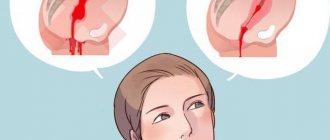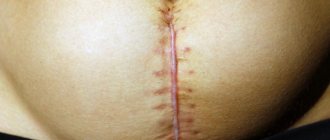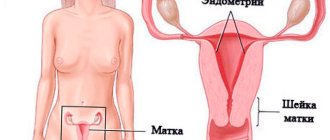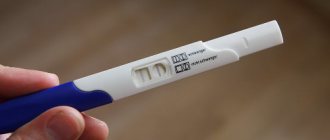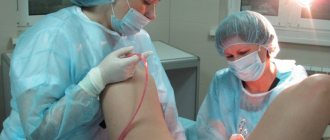Distinctive features
Any operation, like childbirth itself, is a serious stress for the body, tired after pregnancy. Therefore, a woman needs to listen to him sensitively, feel the slightest deviations and know what discharge should be like after a cesarean section and what is considered normal. This will allow her to notice warning signs in a timely manner and receive treatment if necessary. Many sources indicate that lochia after a CS is no different from those that occur after natural childbirth. In fact, this is far from the case. Differences still exist.
- The wound surface is much more extensive after a cesarean section, so the risk of infection or inflammation of the genital organs is very high. So, during discharge after surgery, you need to especially carefully carry out all the prescribed hygiene procedures and not just once a day.
- At the very beginning, just after a cesarean section, about 5-7 days, the discharge is not only bloody, but also contains a lot of mucus, which is not observed after natural delivery.
- The normal color of the discharge after a cesarean section for several days is bright red, deep scarlet, and it is much juicier than during the natural process of childbirth.
- Contraction of the uterus and its healing after cesarean section is a longer and more protracted process, so the duration of the discharge is also different and is 1-2 weeks longer.
These differences should not frighten or worry a young mother, perhaps not yet experienced in such matters, since this is the norm for discharge after a cesarean section, which indicates that everything is in order. But in order to see that something is wrong in time, you need to know about deviations, which will first of all have to be addressed to specialists. Usually they differ little from problematic lochia after natural childbirth.
https://youtu.be/Xa7BJzcEpls
Features of lochia after cesarean section
After cesarean lochia there are differences that you need to know about.
Discharges that do not deviate from the norm and are considered common in this situation are characterized by the following features:
- Immediately after the operation and for 2-3 days they have a bright red color.
- After a week, they transform and are characterized by a brown tint.
- At the end of the month they become more transparent.
Such discharge after cesarean section is considered normal and does not require specialist supervision. They confirm that the operation was successful and does not threaten the life and health of the mother. If other color variations occur, we can talk about the presence of serious changes that require specialist control. The cause of the discharge is the healing process of the endometrium and not a single woman in labor can do without it.
If certain changes or disturbances occur in the body, lochia appears white, green or black. Such discharge is also accompanied by unpleasant sensations in the perineal area, itching, curd-like consistency, and redness.
At this stage, there is no need to postpone this problem; it is important to immediately contact a specialist and begin therapy. Self-treatment by taking antibacterial tablets or suppositories would be inappropriate.
You also need to know how long lochia lasts after surgery in order to control its course and be armed against dangerous diseases. A duration of 45 days is outside the normal range - in such situations you should immediately contact a specialist.
Deadlines
One of the most exciting questions is how long does the discharge last after a cesarean section in order to know for sure whether the recovery period is prolonged or the process is proceeding within the permitted limits. Information about normal periods will allow you to control your actual menstrual cycle, which should soon improve.
Norm
The normal discharge period after cesarean section is from 7 to 9 weeks. So discharge 2 months after cesarean does not pose any danger to the health of the young mother.
Deviations
If after a cesarean delivery the discharge ends too quickly (within 6 weeks) or is very prolonged (up to 10 weeks), this is not yet a reason to panic. Yes, the norms are no longer met, but these indicators can only be determined by the individual characteristics of the body. If the composition, smell, thickness, color, and number of lochia do not indicate complications, there is no need to worry. Although even in this situation, it wouldn’t hurt to tell the doctor about it.
Pathologies
Seeing a doctor is mandatory if the duration of discharge in the postpartum period after cesarean section is beyond the normal range. This is either too quick an end (less than 5 weeks) or too long a process (over 10 weeks). Both are equally dangerous. In the first case, the remnants of the dead endometrium for some reason could not come out and there is a high probability of them festering. If lochia lasts too long, endometritis or an infectious process in the abdominal cavity or genitals can be diagnosed. A condition when the discharge after a cesarean section ends and begins again is also dangerous: this also indicates some deviations in the process of restoration of the uterus.
Knowing how long the discharge lasts after a cesarean section during the normal healing process, a woman does not have to worry that this period is very long or, on the contrary, has passed too quickly. After all, in both cases, you will have to take appropriate measures: go to see a doctor, undergo additional examinations and, if diseases or complications are detected, undergo a course of treatment, no matter how much you would like it.
Be careful . You should not be happy if your discharge has already stopped a month after a cesarean section. Such a rapid process very often ends in inflammation or infection, which requires surgical cleaning of the uterus.
What should be the norm?
If lochia develops after a cesarean section for two months, this is still considered normal. On average, their optimal duration is up to 9 weeks. Such periods are not dangerous for a young mother, are easily tolerated by the body and do not create complications during the recovery process.
Red discharge appears first, then it becomes pale brown and transparent. The mechanism of color transformation has identical indicators to regular menstruation in women, only lochia is longer lasting and occurs exclusively after cesarean section.
Upon completion of the discharge, it is necessary to undergo a second examination by a specialist and take the necessary tests to determine whether there are any certain deviations from the norm.
Lochia character
Throughout the recovery period after surgery, the nature of lochia will change. Initially, blood clots will be released, since the uterus at this time is a large, open, bleeding wound. But over time, during the healing process, they will change to mucus, dead epithelial cells and other postpartum debris.
This also needs to be monitored very carefully. If, for example, bleeding after a cesarean section does not end, this will be an alarming signal that the damaged tissues for some reason cannot regenerate. Such cases require medical intervention and treatment. Therefore, monitor the nature of your lochia and its duration.
- Presence of blood
At first, the presence of blood in the lochia should not raise doubts among young mothers: this is the healing of broken blood vessels and damaged tissue. However, the important point here is precisely the timing, how many days does the bleeding last after a cesarean section: if more than 7-8, then this is already abnormal and you need to sound the alarm.
- Presence of clots
This is also quite understandable during this period of time: they are cells of the already dead endometrium and placenta. After 7-8 days they will go away, so the discharge will become more liquid.
- Mucus discharge
If in addition to the bloody discharge there is also mucous discharge in the first days after a cesarean section, this is also the norm: in this way the body is cleansed of the products of the baby’s intrauterine vital activity.
- Pink discharge
If pink discharge begins a month after a cesarean section, it means that the healing process is not yet complete. Perhaps, under some mechanical influence, the wounded tissues were damaged again. Very often this happens if a couple is impatient and, without waiting for the end of the recovery period, they begin to have sex too early.
- Brown shade
After 6-7 weeks, the nature of the lochia will resemble ordinary menstrual smears of a brownish color: the blood will coagulate and will no longer be so bright and scarlet.
- Purulent discharge
The danger after cesarean section is represented by purulent discharge, which is the first symptom of the endometrium (inflammation of the uterine mucosa). They are usually yellowish-green in color, smell very unpleasant and are accompanied by fever (due to infection), pain in the abdomen and perineum.
- Watery lochia
A young mother should also be alerted to watery lochia, devoid of any shade, almost transparent. This can result in the release of transudate, a fluid contained in blood or lymphatic vessels. This is bad, as it indicates poor circulation in this area. In addition, watery discharge after cesarean section with an unpleasant odor reminiscent of rotten fish is a symptom characteristic of vaginal dysbiosis (gardnerellosis).
If you had to give birth by cesarean section, you must definitely monitor the nature of the discharge that begins. It is the impurities in their composition that may indicate a particular disease that will need to be identified and treated. Often all this threatens the hospital walls again - and this is precisely at the moment when the mother so needs her baby. It is much easier to prevent the problem and enjoy unforgettable moments of communication with the baby. In addition to character, the color of the discharge can tell a lot.
Deviations of lochia and their causes as a cause for concern
Unfortunately, the postpartum period is not always problem-free. In some cases, complications cannot be ruled out that the young mother must recognize in time.
Earlier termination of lochia may indicate that the uterus has not completely cleared itself of dead endometrium (lochiometra - retention of lochia in the uterus), which can cause inflammatory processes in its cavity. In this case, the formation of blood clots in the fallopian tubes cannot be ruled out.
The lingering nature of lochia is a sign of possible endometriosis or infection of the genital organs. Abundant lochia that does not stop for a long time is an alarming sign that the body, for some reason, cannot recover.
The sudden appearance of discharge after its complete disappearance is also considered to be a pathology..
All these deviations require the help of a qualified specialist.
Discharge with an unpleasant odor
In the first days after a cesarean section, the musty odor of lochia is normal, but its persistence or intensification in the future is a cause for concern. Vaginal discharge during the postoperative period should not be sharp or unpleasant. The fishy smell that accompanies lochia is a sign of vaginal dysbiosis (gardnerellosis).
Violation of the vaginal microflora (its population with pathogenic bacteria) is accompanied by a grayish-white discharge with an unpleasant odor of rotting fish
Yellow (purulent) and green discharge
Towards the end of the recovery period, the discharge becomes lighter and may take on a pale yellowish tint. This is a discharge with a predominance of mucus. This condition is considered normal.
But there are cases when yellow discharge is explained by the predominance of leukocytes in the discharge, which protect the body from infections. Since the female body is weakened during the recovery period, the genital mucosa does not fully fulfill its protective function. It is necessary to take measures to protect yourself from bacterial contamination. If the discharge is bright yellow or orange, you should also consult a doctor. Such discharge signals possible endometritis.
Endometritis is accompanied by fever and persistent pain in the lower abdomen and lower back. A woman in such a situation should not self-medicate
Endometritis, unfortunately, is often diagnosed in women who have had a cesarean section: microbes enter the wounded uterine tissue (when the baby is removed from the womb, the vessels connecting the placenta and the uterine wall are damaged) and cause inflammation.
The incidence of endometritis after spontaneous birth is 2-5%, after cesarean section - 10-20%.
Sergey Titov obstetrician-gynecologist of the Federal Center for Expertise and Rehabilitation, Ph.D.
https://www.9months.ru/oslojneniaposlerodov/702/poslerodovoy-endometrit
Green lochia with a putrid odor is also said to be a complication. Green color signals the occurrence of an inflammatory process in the uterus, in advanced cases - purulent. However, only a doctor can accurately diagnose the disease.
Watery lochia
Watery transparent lochia is more of a pathology than a norm. Their appearance may be associated with transudate - fluid accumulating in the uterus due to impaired circulation of blood and lymph.
White curdled discharge
White cheesy lochia, accompanied by itching, redness of the genitals, and a characteristic sour odor, should cause alarm in a woman in labor. Such symptoms may indicate the appearance of pathogenic fungal microflora in the vagina (candidal colpitis), the development of which may be associated with taking antibiotics after cesarean section. You need to see a doctor who will conduct a qualified diagnosis of the disease and prescribe treatment.
Hue
Normally, the color of lochia after a cesarean section should be red at first, followed by brown discharge (towards the end). The rest of the color palette should alert the young mother and force her to go to the hospital for an additional examination to find out if everything is in order with the restoration of her body.
Yellowness
If yellow discharge begins after a cesarean section, it may indicate the following postpartum processes:
- pale yellow, scanty lochia by the end of 2-3 weeks is normal;
- bright yellow, almost orange discharge with a greenish tint, putrefactive odor on days 4-6 - a symptom of pronounced, but just beginning endometritis;
- copious, mucous, yellow discharge after 2 weeks is a sign of already hidden and, most likely, rather advanced endometritis.
Endometritis cannot be treated on its own: antibiotic therapy or even surgery will be required.
Greenery
It is not difficult to guess that the green discharge that began after a cesarean section is explained by the presence of pus in it. It indicates the occurrence of an infectious, inflammatory process in the uterus. Only a medical examination will help determine its cause and diagnose the disease.
White lochia
By itself, without accompanying symptoms, white discharge, which may begin some time after a cesarean section, does not pose a threat. But as soon as certain signs appear, you need to be alert. These include:
- itching of the perineum;
- redness in the intimate area;
- if there is discharge with a sour smell;
- cheesy consistency.
In such cases, a bacterial culture or vaginal smear is required for an accurate diagnosis and appropriate treatment.
Black
If after a cesarean section there is black discharge without odor or pain, it should be taken as normal. They are dictated by hormonal changes in the blood after childbirth. A deviation is if they occur some time after the operation.
To avoid complications of the recovery period after cesarean section, you need to monitor the color of postpartum discharge. She can suggest a problem at the very beginning. This will make it easier to eliminate it and allow you to quickly return to normal after completing the necessary course of treatment.
When to see a doctor
The body of women is sometimes unpredictable, especially at a time when serious hormonal disturbances occur in it. Uterine bleeding after cesarean section is a normal and common occurrence, but only if it has a standard duration and is not characterized by pain or its characteristic color.
The reasons why you should consult a doctor for examination are the following situations:
- Low or increased volume of discharge. This is a deviation from the norm and requires increased attention. If lochia was intense for several weeks and then suddenly stopped, this is a reason to visit a specialist. This may indicate that an increased amount of blood has entered the uterus, as a result of which it cannot contract at an optimal speed. If you do not visit a gynecologist, you may encounter a problem such as endometritis.
- The discharge lasts longer than indicated. This problem is worth paying special attention to, because an increased amount of discharge leads to the formation of hypotonic bleeding.
- Severe pain in the abdominal area. Any unpleasant manifestations indicate that unnatural processes have begun in the body.
- The appearance of an unpleasant odor and pus impurities. This phenomenon is considered dangerous for women at any age. Only timely examination and prescription of the necessary medications will protect your health from complications.
These are the most important reasons why you need to urgently seek medical help. But there are also some less dangerous symptoms that still require urgent help from specialists in order to avoid serious complications and consequences:
- a sharp increase in body temperature;
- a lot of lochia comes out;
- the appearance of unpleasant itching;
- cessation of discharge for 1-2 days;
- the appearance of a burning sensation, signs of thrush;
- formation of pus in the discharge;
- watery clear discharge.
If such symptoms are additionally observed, you need to urgently contact a specialist who will take the necessary tests, examine the woman’s uterus, and find out the cause of such manifestations. If you contact a specialist in time, you can prevent the occurrence of unpleasant sensations and speed up the recovery process.
It is also important to pay attention to the smell of the discharge present. In the first weeks, you should notice the smell of fresh blood, which indicates that the process is happening correctly and there are no deviations from the norm. If lochia is accompanied by an unpleasant odor and creates discomfort, there is a possibility of infection of the uterus. The smell can be associated with sour foods, rottenness, and can be pungent and unpleasant. There is no need to consider such manifestations as the norm. It is important to take the time to take care of your health by visiting a specialist.
Quantity
A young mother also needs to pay attention to how much lochia comes out of her in order to judge how the body’s recovery is proceeding. If after a cesarean section there is little discharge, especially in the very first days, this may be an alarming signal that the tubes, uterine ducts are clogged, a blood clot has formed, etc.
The opposite situation is no less dangerous: profuse lochia that does not stop for too long is an alarming signal about the impossibility of full restoration of the uterus after surgery. In both cases, you need to undergo a special examination and find out what is the reason for such deviations.
Any woman wants postpartum lochia to end as soon as possible and nothing to overshadow happy motherhood. However, there is no need to be too hostile towards them. It is they that can serve as that alarming and sometimes the only signal that not everything is in order with the restoration of the body and some measures need to be taken to help it. You should especially be wary of discharge after a cesarean section with an odor and an unrealistically bright hue. This almost always ends with a course of antibiotic treatment, which is highly undesirable during lactation, or another surgical intervention.
Doctors' recommendation
There are a number of conclusions about the dangers of washing cosmetics. Unfortunately, not all new mothers listen to them. 97% of shampoos use the dangerous substance Sodium Lauryl Sulfate (SLS) or its analogues. Many articles have been written about the effects of this chemistry on the health of both children and adults. At the request of our readers, we tested the most popular brands.
The results were disappointing - the most advertised companies showed the presence of those very dangerous components in their composition. In order not to violate the legal rights of manufacturers, we cannot name specific brands. The Mulsan Cosmetics company, the only one that passed all the tests, successfully received 10 points out of 10 (check out). Each product is made from natural ingredients, completely safe and hypoallergenic.
If you doubt the naturalness of your cosmetics, check the expiration date; it should not exceed 10 months. Be careful when choosing cosmetics, this is important for you and your child.
Regardless of whether the birth turned out to be natural or surgical, the inner lining of the reproductive organ needs time to recover. On average, it lasts 5-9 weeks, unless complications arise. Particular attention is paid to discharge after cesarean section. In obstetrics they are called lochia.
Lochia includes blood, rejected epithelial particles and mucus. There are no fundamental differences between the discharge that occurs after a physiological birth and those that appear after a cesarean section. Most women treat them like menstrual bleeding. By indicators such as the smell, color and volume of discharge after a cesarean section, you can judge whether everything is all right with the new mother.
Normal discharge after cesarean section - what does it look like and how long does it last?
In the early postoperative period, discharge after cesarean section can be easily compared with normal heavy menstruation - the lochia is colored red and contains individual clots.
In the first 7 days after surgery, their total volume can reach 500 ml; normally, a sanitary pad should be filled no faster than 2 hours. Every day the doctor checks with the woman the number of lochia and their color.
Discharge after cesarean section increases with physical activity, breastfeeding, and palpation of the abdomen. As a result of these actions, the natural contractile activity of the uterus is stimulated, due to which its contents are more effectively expelled.
From the 2nd week, the lochia begins to darken, acquiring a brownish tint. Their volume gradually decreases. By the end of the 5th week, blood discharge after a cesarean section should normally become spotty, weak and acquire a lighter shade.
At the 8th week, the process of restoration of the inner layer of the reproductive organ is almost completely completed. Thus, the discharge after a cesarean section becomes light after 2 months, just like before pregnancy. At this time, the woman is recommended to visit a gynecologist for an appropriate examination and selection of a contraceptive method.
The nature and intensity of lochia is influenced by contractions of the uterine myometrium. After a birth performed by cesarean section, this process is worse than after a natural one, since part of the muscle fibers are damaged as a result of the surgical incision.
To improve the contractile activity of the uterus and prevent the development of postpartum hemorrhage, immediately after the operation the woman is started to be administered the drug Oxytocin according to the scheme, and it is also strongly recommended to establish natural feeding to enhance the synthesis of oxytocin by the body.
Personal hygiene after cesarean
Personal hygiene after surgical delivery has its own nuances:
- Sanitary pads are changed as needed, but at least every 3 hours.
- The use of tampons during the postpartum period is strictly prohibited, since their use can cause the development of an infectious process.
- After each visit to the toilet, a woman should wash her genitals with clean water.
- You cannot douche or take a bath until the end of the recovery period, only take a shower.
In what cases should you consult a doctor?
Every woman who has become a mother through surgery should be informed about how long the discharge lasts after a cesarean section. The cessation of lochia too early, as well as prolonged cessation, can be a bad sign.
But doctors insist that it is not so much the time frame that is important, but the composition, color, smell and total number of lochia. If the nature of the discharge is normal, then there is nothing to worry about. And how long the discharge lasts after a cesarean section depends almost entirely on the specific characteristics of the body. But even in this situation, you should consult a doctor.
It is imperative to inform a specialist if lochia ends too early - less than 5 weeks, or too late - continues 10 or more weeks after birth. Both of these conditions pose serious risks.
In the first situation, the uterus may not have been completely cleansed and blood, mucus and remnants of the epithelium remain in it, which often ends in a serious inflammatory process. This should be indicated by discharge after a caesarean section with an odor. Read more about why the uterus contracts poorly after childbirth→
Prolonged lochia is also the result of an infectious process - endometritis. There is also a danger when the discharge either ends or increases again: such a case also does not fit into the norm.
Yellow discharge after cesarean section without the presence of a foreign odor is normal only at the end of the first 3 weeks after birth. But if they continue after this time, they are considered a sign of pathology - an advanced form of endometritis, which must be treated under the supervision of a doctor.
Purulent discharge after cesarean section colored green indicates the presence of an acute infectious pathology in the uterus.
White discharge from the genital tract is not dangerous until it is accompanied by symptoms such as redness and itching in the intimate area, discharge with a sour odor and a cheesy consistency. Most likely, we are talking about vaginal candidiasis - a frequent companion to antibacterial therapy, which is necessarily prescribed after surgical delivery. But only a specialist can give an accurate diagnosis.
By observing how long the discharge is after a cesarean section, assessing its nature, the young mother will understand whether her postpartum recovery stage is being delayed or everything is fine. If deviations from the norm occur, do not hesitate to consult a doctor. The examination and course of treatment that you will have to undergo if necessary are trifles compared to the complications that can arise if you let the situation take its course.
Doctors' opinion
I share a quote from my colleague, an obstetrician-gynecologist with twenty years of experience, Elena Sidorenko: “The first thing I always try to explain to my patients is that discharge after a cesarean section is not a regulation. And don't panic when they last too long. On the contrary, scant lochia that runs out very quickly should be a cause for concern, as this is an indicator of a failure in the recovery process.
What should be more alarming is not even how long the discharge lasts, but its characteristics after a cesarean section. Even if they last more than two months, but do not have an unpleasant odor, gray, green or deep yellow inclusions - excellent. After all, this means that your uterus is completely freed from endometrial particles and dead cells, returns to normal, there are no complications or infections.
Of course, a woman who has recently given birth to a baby should be very attentive to herself - not lift heavy things, keep her body clean, and eliminate bad habits. After all, 80% of it affects its own condition and reproductive health.”
What else should you pay attention to?
A woman should be concerned not only about the changed nature of postpartum discharge, but also about such alarming signs as abdominal pain and fever. But the last symptom may also be a variant of the norm if the young mother has not yet established lactation and the first pronounced flow of milk is observed.
Sometimes, due to insufficient care or infection, a woman in the postpartum period develops discharge from the suture after a cesarean section.
This pathology is characterized by the following symptoms: hyperemia, fever, swelling and sanguineous or purulent discharge from the suture after cesarean section. If you do not notice this complication in time or self-medicate, the suture will fester and the young mother will need surgical help.
Typically, every woman who has become a mother by cesarean section visits a specialist 2 months after the birth of the baby. During this time, it becomes known how the recovery process is proceeding and whether there are any complications. But the woman will have to monitor whether postpartum discharge is normal on her own in order to seek medical help in time.
Author: Olga Rogozhkina, doctor, especially for Mama66.ru
What do gynecologists think?
Gynecologists recommend paying close attention to your health not only after natural childbirth. It is during the period after the operation that a woman faces serious complications, such as: discharge lasts for a long time, or is absent altogether, unpleasant sensations appear, and a strong odor from the vagina.
Gynecologists often encounter such a problem as deviation of lochia from the norm. The reasons for this are various concomitant diseases or conditions caused by unnatural childbirth. If heavy discharge appears or, conversely, the volume of lochia decreases, you should immediately contact a specialist to find out the main reasons for this phenomenon.
There are many gynecological diseases caused by the pathological course of lochia.
- Endometritis
Characterized by inflammatory damage to the uterine epithelium. This disease increases the amount of discharge, it becomes purulent and causes a lot of discomfort for women. If you have such a disease, gynecologists recommend regular examinations.
- Thrush
Occurs during a period of sharp decline in immunity. After a cesarean section, lochia is observed in combination with cheesy formations, which provoke an increase in the period of discharge.
- Parametritis
The occurrence of the disease is provoked by pathogenic microorganisms that can enter the body during a cesarean section. If you experience severe sweating, dizziness, or abdominal pain, you should consult a gynecologist.
After a caesarean section there should be some discharge, this is normal. If, in combination with these, serious deviations in health are noted, a trip to the gynecologist should not be postponed.
Doctors say that the discharge lasts no more than 2 months; ideally, lochia after a cesarean section should end in 1.5 months. If the period is exceeded, you need to monitor any changes in well-being, observe the color of the lochia and the odor present. All this may indicate the presence of certain changes and disorders in the body.
Useful video about caesarean section
https://youtu.be/MlejBq-8llc
We recommend reading: Uterus after cesarean section: features of the recovery period
A caesarean section is a serious abdominal operation that does not occur without complications and requires a long process of recovery of the woman’s body. How long it will last depends on many individual characteristics; it may take from 42 to 56 days, while the body after a natural birth completely returns to normal within a month. One of the consequences of labor is lochia, which appears regardless of the type of birth, but in the case of artificial obstetrics requires special attention, because it can indicate more serious complications.
How long do lochia last?
The duration of lochia depends on the following factors:
- presence of infections;
- weight and height of the newborn baby;
- number of births;
- number of births by caesarean section;
- lactation.
On average, after a cesarean section, lochia appears within 30-45 days. The maximum duration in the presence of certain physiological disorders is 60 days. Many people wonder how many days do lochia last after a natural birth? After a natural birth, the discharge may last longer, up to 45 days, given that there were no complications.
How long have you had lochia?
1 monthMore than 2 months
Lochia after cesarean section, which lasts for 1.5-2 months, leads to disorders such as anemia. How long lochia occurs and with what intensity depends on the physiological characteristics of each woman. Up to 45 days is considered normal, but an increased number of days cannot indicate the presence of serious complications.
Postpartum discharge as a common physiological phenomenon
Lochia is a specific postpartum blood discharge with inclusions of endometrial clots formed after the separation of the placenta in the wound. They consist of blood cells (these are red blood cells, platelets, leukocytes), plasma (the so-called liquid part of the blood), mucus and particles of dead epithelium. The structure of discharge after a cesarean section is absolutely identical to that which appears after a natural birth, and if there are no serious complications in the postpartum period, they gradually disappear. But any pathological processes that develop in the postpartum period in the uterine area are reflected in the appearance and amount of discharge. Therefore, every woman needs to know what they should be in order to promptly identify:
- infectious process;
- inflammation;
- uterine scar, which provokes large blood loss.
Duration of postpartum discharge
A particularly pressing question for young mothers is: how long does discharge last after childbirth? The average duration is 30-40 days. This time is enough to restore the uterine epithelium. However, the timing is very individual.
This depends on several factors:
- how was the pregnancy
- how was the birth
- How actively does the uterus contract?
- Method of delivery: cesarean section or natural birth
- Does mom breastfeed?
In nursing mothers, postpartum lochia ends faster than in those who refuse breastfeeding. During breastfeeding, a large amount of the hormone oxytocin is released, which promotes active contraction of the uterus.
If bleeding continues for more than two months or less than two weeks, then this is a reason to pay attention to the nature of the discharge: its color, smell and composition. The development of a pathological process is possible.
